Land, People, Language: Teacher's Guide
“Land, People, Language” is the second of four themes within Dene Studies curriculum in the late 1908s, including “Dene Then: Precontact,” “ “Dene History,” and “Dene Now.” It focuses on several key themes, including the relationship between Dene and the land rather than the Dene/Métis land claim, which is a part of “Dene Now.”
In addition, these documents were released prior to Dene language standardization, and the introductory section comments that while Dene languages could be a component of this course, “ways in which Dene languages are written are under development, and pronunciation is difficult to show and follow on a printed page.” (1) However, “A minimum level of language work should be done with the Dene vocabulary includedin the Readings, [including] Dene names for places and people… phrases and terms [from]… allsections of this course” and lessons drawn from community resource people, videos, and films. (1-2) Activities include discussion topics such as: “Discuss levels of responsibility for maintaining and using a language.” “Languages can grow, or they can die. Think of examples of each. What things seem to influence whether a language grows, or dies?” (26) “Trace the steps a community would follow if it wanted to establish a community language program.” (30)
Access this Resource:
Dene Studies curriculum documents are held in the NWT Archives. See item no. N-2007-014: 1-1.
Dene Studies Project Team. Land, People, Language, Teacher’s Guide. Yellowknife: Northwest Territories Department of Education and the Dene Nation, 1988.
Introduction to Dene Studies: Teacher's Guide
This document is a preface to a Grade 10 Dene Studies course, to be piloted in 1988/89. Dene studies curriculum was produced by the Department of Education of the Northwest Territories and the Dene Nation beginning in 1986-1987. The 1987-1988 Dene Studies project team included Georgina Blondin, Ernie Camsell, Cheryl Fennell, Cynthia Flood, Bruce Fraser, Patricia Keays,and Patricia Robison. The document outlines Grade 10 Dene Studies design, structure, content, and approach; forexample, learning objectives around the significance of the Dene drum. It also provides a reading list and outlines several activities.
An illustrative section of the text: Principles on which Dene Studies is based reads, “1. Culture is learned. We learn fully about culture in communities, with people, not in a classroom. The instructional setting limits the aspects of culture that can be explored, particularly when the culture under study is land and group/community based. Dene Studies concentrates on those aspects of culture that can be taught in a classroom, but recognizes that classroom study alone will not lead to full knowledge and understanding of Dene culture.” (4)
Access this Resource:
Dene Studies curriculum documents are held in the NWT Archives. See item no. N-2007-014: 1-1.
Dene Studies Project Team. Introduction to Dene Studies, Teacher’s Guide. Yellowknife: Northwest Territories Department of Education and the Dene Nation, 1988.
Dene Ke Tatso Yéhdá Negerı́chú
This is a unilingual story with hand-drawn illustrations and North Slavey text. There is an English guide at the end (p.28) which explains that a group of dene people lived on an island happily, along with Tatsǫ́ (the Raven). Tatsǫ́ was a prankster, and was so disruptive that the dene took away his beak. Tatsǫ́ tries to trick them by making mud people to distract the community so he can steal his beak back. He takes it from a blind elder, who mistakes him for a child. He flies away with his beak returned to him. This document has a stamp on the last page that reads “Interpreter/Translator Program.” The first two lines read:
Yahnı̨́ı̨ ts’ę́ dene ło du k’e gonezǫ́ nágedé. Du k’e gonezǫ́ t’á dene surı́ gogha gonezǫ. Eyu du k’e dene nágedé goghá Tatsǫ́ k’ola nágwe redı. Tatsǫ́ dene keg ok’áláwe zǫ. Tatsǫ́ goɂǫ́ dene ke gok’áláwe, hé goɂǫ́ gode zǫ t’á dene ke gogha nezǫ́ le.
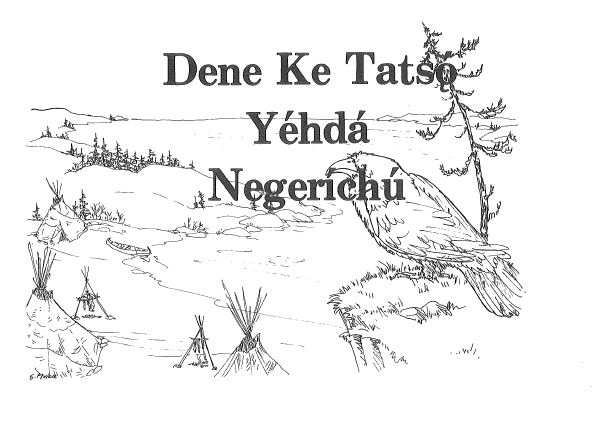
Access this Resource:
Available from the Ɂehdzo Got’ı̨nę Gots’ę́ Nákedı archives. Contact This email address is being protected from spambots. You need JavaScript enabled to view it. for access and see the Release and User Agreement form on the database home page.
Tetso, John, Elsie Vital, Gina Bayha, Gloria Lafferty Miller [Illustrator], Jane Modeste and Fibbie Tatti [eds.]. Dene Ke Tatso Yéhdá Negerı́chú. Délı̨nę: Fort Franklin Band Council, 1986.
Asiı̨́ı̨ Bemǫne Gúlı́ Héoratı’ı̨ [Adapted from "Shapes," a curricular text published by Usborne/Hayes]
This is a unilingual storybook that teaches North Slavey terminology using shapes, silhouettes, and pictures. It appears to be adapted from a basic curricular text, “Shapes,” for Dene language learning.
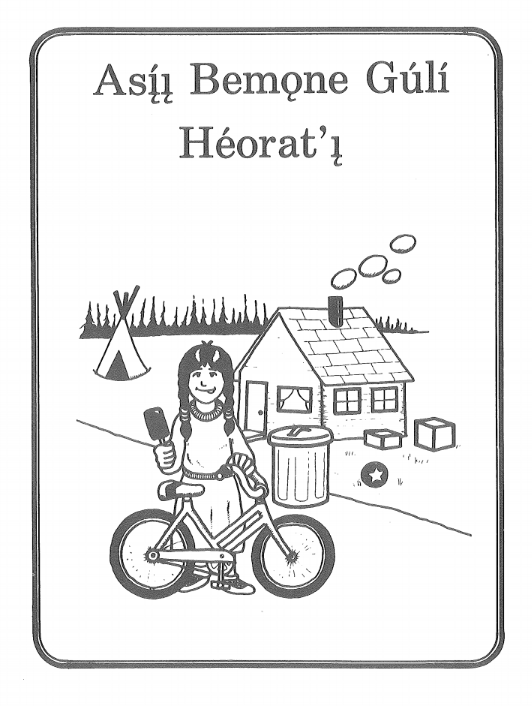
Access this Resource:
Available from the Ɂehdzo Got’ı̨nę Gots’ę́ Nákedı archives. Contact This email address is being protected from spambots. You need JavaScript enabled to view it. for access and see the Release and User Agreement form on the database home page.
Tatti, Fibbie, and Darin Ouellette. Asiı̨́ı̨ Bemǫne Gúlı́ Héoratı’ı̨. Adapted from Shapes, published by Usborne/Hayes. Yellowknife: Department of Education of the Northwest Territories, 1985.
Ɂehtsée Gah
This is a unilingual story with hand-drawn illustrations and Dene text, about an elder telling his granddaughter stories about rabbit, and teaching her lessons on the land.
Ɂı̨hbé ekúu kare gonezǫ t’á ts’ǫ́dane ke kare nágogeye. T’ere łée Gahzhoó héredı sı̨́ı etı̨́whęnę t’á ɂehke ke k’énategehde zǫ.
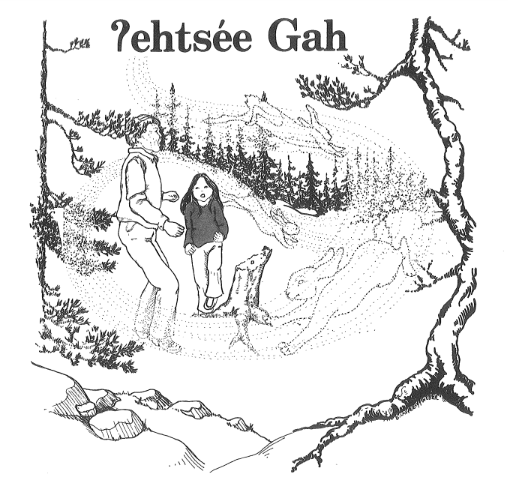
Access this Resource:
Available from the Ɂehdzo Got’ı̨nę Gots’ę́ Nákedı archives. Contact This email address is being protected from spambots. You need JavaScript enabled to view it. for access and see the Release and User Agreement form on the database home page.
Lafferty, Gloria, Mitsuko Oishi, Ronald Cleary, and Christine Cleary. Ɂehtsée Gah. Northwest Territories Department of Education. School Program Services, 1984.
Tatsǫ́ Ts’éku Hedenı̨́htł’é
This is a unilingual story with hand-drawn illustrations and Dene text. A community of animals is living peacefully until Raven, Tatsǫ́, plays a trick of some kind, is caught, and is forced to fly off by the rest of the group. The first section reads:
Tatsǫ́ Ts’éku Hedenı̨́ht’é
Yahnı̨́ı̨ ts’ę́ tı̨ch’ádı́ı sı̨́ı̨ dnee hı̨lé redı. Ekúu sı̨́ı̨ tı̨́ch’ádı́ı ke ası̨́ hóoyı̨́ı̨ gha, Tatsǫ́ gehɁa zǫ redı. Łánu dene ke nádé ghá Tatsǫ́ ts’u k’e danéhtła gháré, surı́ nǫhbále náaweɂa tah gogháeda.
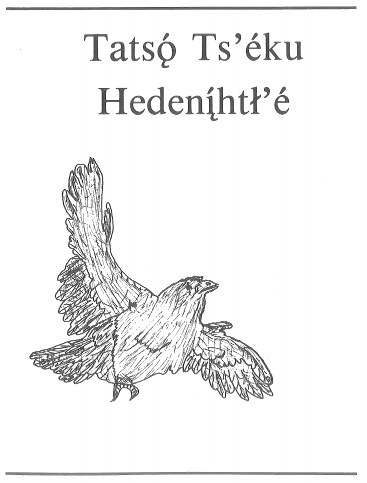
Access this Resource:
Available from the Ɂehdzo Got’ı̨nę Gots’ę́ Nákedı archives. Contact This email address is being protected from spambots. You need JavaScript enabled to view it. for access and see the Release and User Agreement form on the database home page.
Modeste, Jane, John Tetso, and Fibbie Tatti. Tatsǫ́ Ts’éku Hedenı̨́htł’é. Yellowknife: Program Services Division, Department of Education, Government of the Northwest Territories, 1984.
Koyére: Reader II Teacher Guide
This text is a teacher’s guide and lesson plan to go along with a Dene Reader. It is written primarily in English, with North Slavey provided in places where a teacher should ask a question of students in the Dene language, for example.
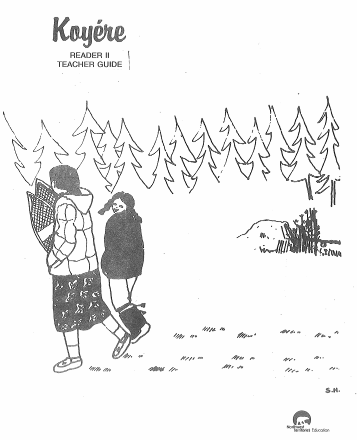
Access this Resource:
Available from the Ɂehdzo Got’ı̨nę Gots’ę́ Nákedı archives. Contact This email address is being protected from spambots. You need JavaScript enabled to view it. for access and see the Release and User Agreement form on the database home page.
Tatti, Fibbie, Mitsuko Oishi, and Doreen Cleary. Koyére: Reader II Teacher Guide. Northwest Territories Department of Education. Programs Services Division, 1984.
Chųą hé Túrıłǫ
This text includes a list of bird-related vocabulary words, in English, with some accompanying pictures. While there is no North Slavey visible in the document, it was likely intended to be used as a Dene teaching tool.
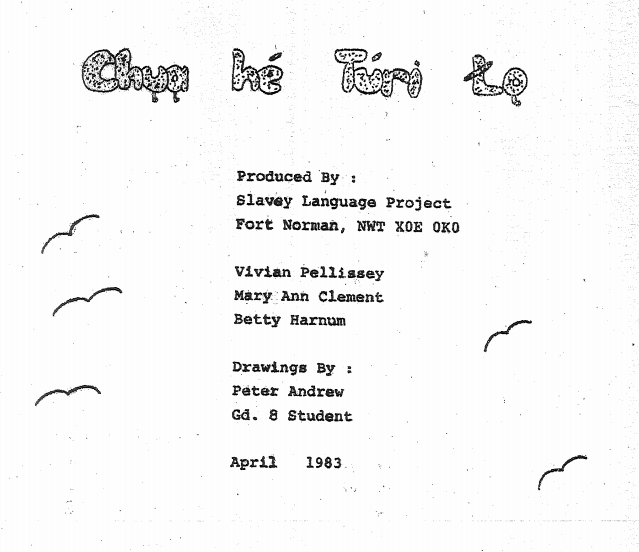
Access this Resource:
Available from the Ɂehdzo Got’ı̨nę Gots’ę́ Nákedı archives. Contact This email address is being protected from spambots. You need JavaScript enabled to view it. for access and see the Release and User Agreement form on the database home page.
Pellissey, Vivian, Mary Ann Clement, and Betty Harnum. Chųą hé Túrı łǫ. Fort Norman: Slavey Language Project, 1983.
Tsá ɂerı̨ı̨tł’é
This text includes a list of beaver-related vocabulary words, in English, with some accompanying pictures. While there is no North Slavey visible in the document, it was likely intended to be used as a Dene teaching tool.
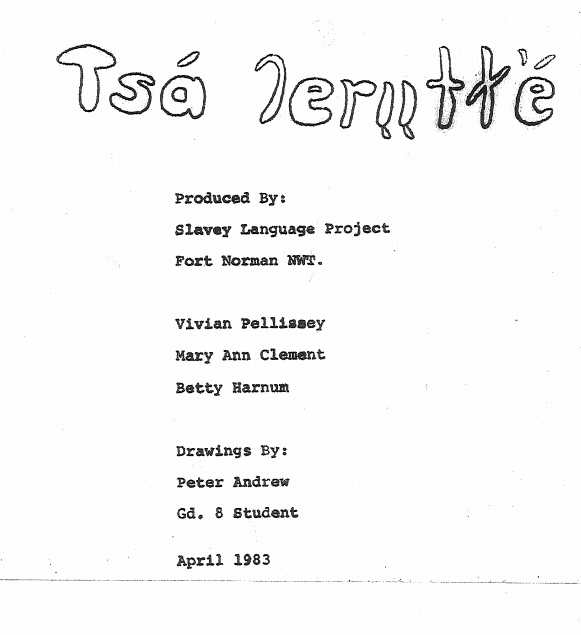
Access this Resource:
Available from the Ɂehdzo Got’ı̨nę Gots’ę́ Nákedı archives. Contact This email address is being protected from spambots. You need JavaScript enabled to view it. for access and see the Release and User Agreement form on the database home page.
Pellissey, Vivian, Mary Ann Clement, and Betty Harnum. Tsá ɂerı̨ı̨tł’é. Fort Norman: Slavey Language Project, 1983.
Tatsǫ́ Sa Naarı́chú
This is a unilingual story with hand-drawn illustrations and Dene Kedǝ text. From the illustrations, it looks like there is a conflict between bear and dene people, wherein a bear has taken the sun and put it in a pouch. Raven somehow solves the problem and unties the pouch, freeing the sun. The story begins:
Yahnı̨́ı̨ ts’ę sah dene ts’ę hıché dúwé t’á dene ghá sa nerı́chú redı.
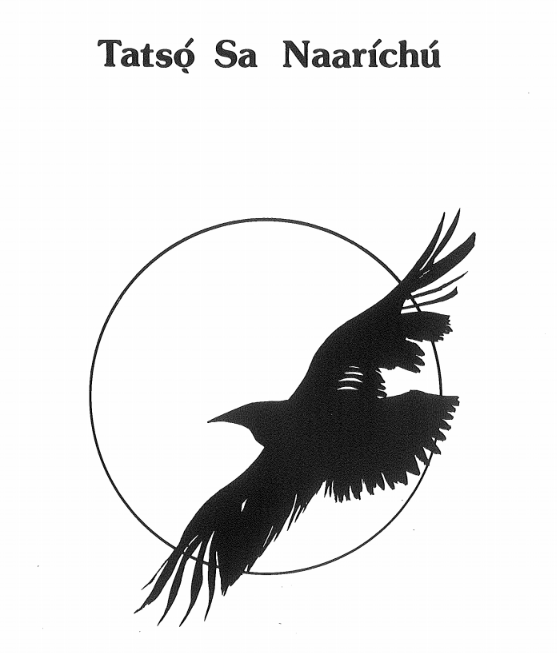
Access this Resource:
Available from the Ɂehdzo Got’ı̨nę Gots’ę́ Nákedı archives. Contact This email address is being protected from spambots. You need JavaScript enabled to view it. for access and see the Release and User Agreement form on the database home page.
Taneton, Louie, Jane Modeste, Fibbie Tatti, Sheila Hodgkinson [Illustrations]. Tatsǫ́ Sa Naarı́chú. Yellowknife, Programs and Evaluation Branch, Department of Education, Government of the Northwest Territories, 1983.




 Phone: 867-374-4040
Phone: 867-374-4040 Email:
Email: